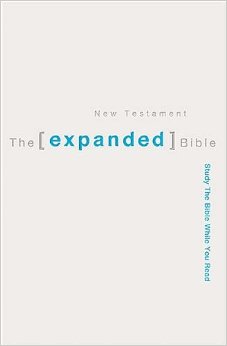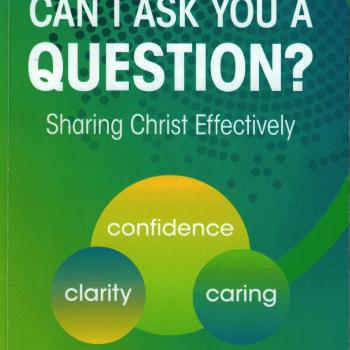
The Expanded Bible by Thomas Nelson Publishers
The Expanded Bible by Thomas Nelson Publishers is a New Testament which was written to help people understand the Bible. There are a variety of editing devices to help the readers. The editors take great pains to make sure that the words of this translation are made clear. Clarification is made in different ways (I have noted the clarification used in The Expanded Bible in quotes. My comments are below each quote):
[ ] – EXPANSION: Other possible ways of translating a word, phrase, clause, or sentence. Expansions are enclosed within a set of brackets [ ], and provide synonyms, different nuances, or sometimes more sophisticated diction.
The use of expansion works like the Amplified Bible. Words are added, not to add to the Bible but to help the reader know different ways of saying the same thing.
[or] – ALTERNATE: A different translation possibility that takes the meaning of the original language in a different direction than the base text does. Alternates provide information not possible in a standard translation, which must choose between possibilities for its main text. These are signaled by an “or” within a set of brackets: [or].
In most translations, this information is but in a footnote. In this case, the writers thought it best to place it in the text.
L – LITERAL: A more literal rendering of the original language, allowing the reader to see why translations make varying choices.These are signaled by a superscript L within a bracket: [L ].
This notation will help the reader understand from the original language the most literal translation of the English word. Traditionally, this is done by people who translate Greek and Hebrew. In this case, the most literal translation is given.
T – TRADITIONAL: Provides familiar terms and well-known renderings from past translations, especially those in the King James tradition. Signaled by a superscript T within a bracket: [T ].
As notes by the editors, the familiar tradition is given. This may be different from the literal translation.
C – COMMENT: Briefly provides historical, cultural, theological, or other explanatory information to help readers better understand a verse or passage. These are signaled by a superscript C within a bracket: [C ]. (There is no bullet in the base text for these because no replacement is required.)
This make The Expanded Bible (New Testament) not only an amplified Bible, but also a commentary. There is an advantage to this commentary. It helps give clarity to the cultural background of the situation one is reading in the Bible.
As the editors state in the introduction, a bullet is used to show which word is being examined:
For Expansions, Alternates, certain Literals, and certain Traditionals (see below), a bullet (· ) is used to show where to begin the replacement of a word or words before the set of brackets with the word or words within the set of brackets. The Literals and Traditionals that are not associated with a bullet do not require to be substituted for any word or words in the base text, but are just to be added.
This translation also show the reader what words are being “expanded” by the use of a bullet. This helps the reader understand as one reads the text that an explanation is coming. Many times, a commentary or a Bible translation will use footnotes to make show these changes. Some Bibles have comments in the margins. The editors of this Bible purposely decided to insert the information in the text. As someone who reads books, seeing that I have to read a footnote can detract me from the main idea I am reading. I have to refocus to get back on track. This problem is not avoided by the what these editors have done with the Expanded Bible. However, it seems to help keep the reader focused on the Biblical text. If that was the goal, then they have succeeded.












